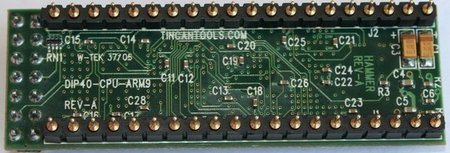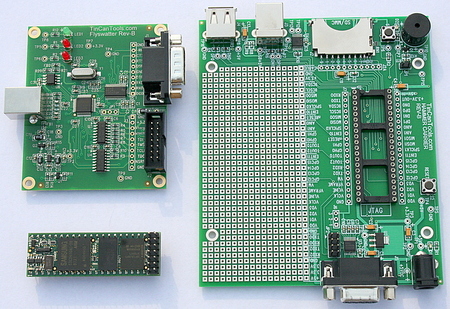Linux computer fits in 40-pin chip socket
Nov 19, 2007 — by LinuxDevices Staff — from the LinuxDevices Archive — 51 views A Texas-based startup is shipping a tiny, low-cost ARM9 SBC (single-board computer) with an open hardware design and Linux-based software. Instead of bringing I/O out to high-density surface-mount connectors, the Tin Can Tools “Hammer” SBC has 40 solder-friendly 0.1-inch pins, for easy prototyping of complex designs,… the company says.
A Texas-based startup is shipping a tiny, low-cost ARM9 SBC (single-board computer) with an open hardware design and Linux-based software. Instead of bringing I/O out to high-density surface-mount connectors, the Tin Can Tools “Hammer” SBC has 40 solder-friendly 0.1-inch pins, for easy prototyping of complex designs,… the company says.
The Tin Can Tools “Hammer” has 40 I/O pins on the bottom, and a 2 x 7 pin JTAG interface on top
(Click each image to enlarge)
digg this story |
According to Tin Can Tools founder Rusty Herod, the high-density connectors on most small boards present a barrier to hobbyists and smaller companies wishing to prototype complex designs. He explains, “You can connect a 0.5 flex connector to it, but you have to solder the other end to something. You may need a scope, and fine-pitched soldering gear, and a converter board to break it out to a bigger pin pitch.”
 SSV's DIL/NetPC (Click for details) |
The Hammer, in contrast, is designed to fit into a “DIP” (dual in-line package) socket, similar to German board vendor SSV's extensive line of tiny DIL/NetPC SBCs (one that recently gained a piggyback WiFi module is pictured at right). Asked to compare his product to similar designs, Herod touted his product's availability in “complete” kit form, including a low-cost USB-based JTAG board, development “carrier” breadboard, and software.
Another plus, Herod says, is the Hammer's open hardware design. Asked specifically how the hardware design is licensed, Herod replied, “The schematics and other design files are available, what I call the 'hard layout.' I haven't put it under the GPL, but I wanted to keep it open. I didn't want to just put in a gate array and hide the code.”
The full Hammer kit includes a Carrier breadboard, “Flyswatter” JTAG board, and the Hammer itself
(Click to enlarge)
Herod traces his career in the SBC market back to 1983, and he also happens to own AML Ltd, a manufacturer of handheld data terminals, many of which run Linux. However, Tin Can Tools is a separate venture, he said, explaining, “This is something I've always wanted to do.” He clearly sounds enthusiastic about being in a position to make hardware engineering more accessible.
The downside of having I/O on large, low-density pin connectors, of course, is that less I/O fits. With only 40 pins, Hammer users must elect whether to use some pins for peripheral interfaces, or for GPIO (general-purpose I/O) lines, as shown in the diagram below.
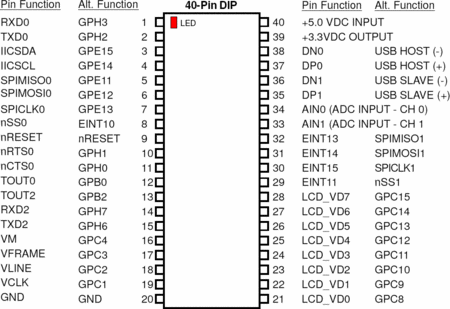
Hammer's pins offer alternative assignments
(Click to enlarge)
The company plans additional designs in the future, possibly including models with more pins, Herod hinted. Hammer is the company's first product. Meanwhile, I/O can always be expanded via “any standard USB dongle,” the company says, suggesting SparkFun's enc28j60 10baseT SPI based controllers and bluetooth UART (pictured below).
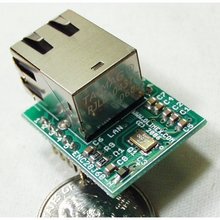
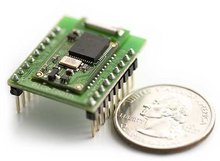
SparkFun's Ethernet and Bluetooth UART DIP modules
(Click either to enlarge)
The Hammer
The Hammer is based on a Samsung S3C2410A SoC (system-on-chip). The SoC integrates a 200MHz ARM920T core with a memory management unit (MMU), and 16KB each of instruction and data cache.
The tiny SBC measures just 0.75 x 2.25 inches. It has 16MB of NOR flash soldered onboard, along with 32MB of 100MHz SDRAM, according to Herod.
I/O reportedly includes:
- 2 x UART's with IrDA support
- I2C interface
- 2 x SPI ports
- 2 x 16-bit Timers/PWM's
- 8-bit LCD Interface + control signals
- USB Host and Device ports
- 2 x 10-bit analog-to-digital converters
- 4 x external Interrupt pins
- Up to 30 pins of GPIOs
Herod notes that some of the GPIO's and peripherals share the same pins. Developers must select either GPIO pins or their alternate peripheral functions (see diagram above).
There's also a standard JTAG interface with a 2 x 7 header. The whole package measures 0.75 x 2.25 inches, and fits into a standard 40-pin DIP socket with pins on 0.1-inch centers. It requires 120 mA of +5V DC power.
On the software side, the Hammer comes with an open source bootloader, Linux 2.6 kernel, and a root filesystem based on uClibc and Busybox, Tin Can said.
Carrier board
The Hammer Carrier Board contains a DC-DC converter, RS232 serial port, USB host and slave ports, and an SD/MMC memory card connector, beeper circuit, and a “large prototyping area on 0.1-inch grids,” according to Tin Can. Like the hammer itself, the carrier board's hardware design is open.
Other touted Carrier Board features include:
- 40-pin machined DIP socket that accepts the Hammer CPU board
- DC power jack that accepts an external 5VDC regulated power supply (2.1mm center positive)
- LM1117 [email protected] voltage regulator for use in the prototyping area
- RS232 connector (DB9 female)
- RS232 transceiver circuit for console communications (2nd port is also available)
- User controlled LED (tied to a GPIO pin on the Hammer)
- User controlled push-button switch (tied to an interrupt pin on the Hammer)
- Reset push-button switch
- Four mounting holes
- Board fits into a PACTEC CM5-125 standard case (available from Mouser Electronics)
- Large user prototyping area (0.100 inch grid)
- Signals from the Hammer CPU board are brought out to the user prototyping
- +5V , +3.3V, and GND busses are available in the prototyping area
“Flyswatter” JTAG board
The Flyswatter can be used to debug the Hammer, or download code to its onboard flash. In addition to the Hammer, it is claimed to support “all ARM processors supported by OpenOCD software.
Touted features and specs include:
- USB 2.0 Full Speed Device (12 Mbits/sec) interface
- Provides a standard 2×7 pin JTAG interface
- Adds a virtual RS232 serial port to a computer or laptop with full modem signals
- Supports ARM target voltages of: 3.3V, 2.5V, 1.8V, 1.5V, 1.2V (voltage range: 1.2V to 3.6V)
- Adds a virtual RS232 serial port to a computer or laptop with full modem signals
- Runs off USB — no external power source needed
- Open hardware — “complete” schematic provided
- Open software — software supported by OpenOCD (open source) debugger
- Included CD comes with OpenOCD for Linux
- Dimensions — 2.5 x 3.0 inches
- Package includes Flyswatter board, USB cable, 8 inch JTAG ribbon cable
Availability
The Hammer SBC is available now, priced at $160, or $250 for a kit that includes the Carrier and Flyswatter boards. Volume discounts are available, the company said.
This article was originally published on LinuxDevices.com and has been donated to the open source community by QuinStreet Inc. Please visit LinuxToday.com for up-to-date news and articles about Linux and open source.
